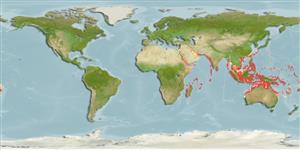Common names from other countries
Classification / Names / Names
Namen | Synonyme | Catalog of Fishes (gen., sp.) | ITIS | CoL | WoRMS
Environment: milieu / climate zone / depth range / distribution range
Ökologie
Riff-verbunden; tiefenbereich 3 - 56 m (Ref. 8294). Tropical; 30°N - 27°S, 32°E - 172°W (Ref. 848)
Indo-West Pacific: Bonin Islands to Australia and Red Sea to Kiribati.
Length at first maturity / Size / Gewicht / Alter
Maturity: Lm ? range ? - ? cm
Maximum depth from Ref. 100940.
Life cycle and mating behavior
Geschlechtsreife | Fortpflanzung | Ablaichen | Eier | Fecundity | Larven
Mature gametes are shed into the coelenteron and spawned through the mouth. Life cycle: The zygote develops into a planktonic planula larva. Metamorphosis begins with early morphogenesis of tentacles, septa and pharynx before larval settlement on the aboral end (Ref. 833).
Ross, M.A. and G. Hodgson. 1981. (Ref. 8294)
IUCN Rote Liste Status (Ref. 130435: Version 2024-1)
CITES Status (Ref. 108899)
Not Evaluated
Nutzung durch Menschen
| FishSource |
Tools
Mehr Information
Alter/GrößeWachstumLänge-GewichtLänge-LängeMorphologieLarvenDichte
Internet Quellen
Estimates based on models
Preferred temperature
(Ref.
115969): 25.4 - 29.3, mean 28.5 (based on 3105 cells).
Preiskategorie
Unknown.
